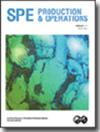泡沫水流的截留率测量和图像处理的流态表征
IF 1.3
4区 工程技术
Q2 ENGINEERING, PETROLEUM
引用次数: 0
摘要
石油和天然气行业最关键的问题之一是用于天然气运输的管道的脱水,注入泡沫似乎是一个突出的解决方案。这项工作有两个目标:主要目标是开发一种光学工具来测量泡沫流中的持液率并进行流态表征,而次要目标是量化表面活性剂注入在减少液体负载方面的有效性。在本文中,我们介绍了一项旨在表征水平管中气液泡沫流动的实验活动的结果。最初,气体和液体表观速度的液体负载测量,范围从0.41到2.30 m/s和0.03至0.06 m/s分别通过专门开发的光学方法进行。对于每种液体表观速度,发现最小持液率位于塞和分层流动状态之间的边界附近,表观气体速度在0.44和0.90之间 m/s。因此,塞流区域对应于执行管道脱水程序的最佳操作条件。此外,通常用于普通两相气液流动的漂移通量模型似乎与空隙率的测量值拟合良好。本文章由计算机程序翻译,如有差异,请以英文原文为准。
Holdup Measurements of Aqueous Foam Flows and Flow Regime Characterization through Image Processing
One of the most critical issues in the oil and gas industry is the dewatering of the pipelines used for natural gas transportation, and foam injection seems to be a prominent solution. This work has two goals: The main one concerns the development of an optical tool to measure the liquid holdup in foamy flows and perform the flow regime characterization, whereas the secondary goal is to quantify the effectiveness of surfactant injection in reducing the liquid loading. In this paper, we present the results of an experimental campaign aimed at the characterization of gas-liquid-foam flows in a horizontal pipe. Initially, liquid loading measurements for gas and liquid superficial velocities, ranging from 0.41 to 2.30 m/s and from 0.03 to 0.06 m/s, respectively, were performed by means of a specifically developed optical method. For each liquid superficial velocity, the minimum liquid holdup was found to lie in the proximity of the boundary between plug and stratified flow regime, with a superficial gas velocity between 0.44 and 0.90 m/s. Hence, the plug flow region corresponds to the best operating condition to perform the pipeline dewatering procedure. Moreover, the drift-flux model usually adopted for ordinary two-phasegas-liquid flows seems to fit well with the measured values of void fraction.
求助全文
通过发布文献求助,成功后即可免费获取论文全文。
去求助
来源期刊

Spe Production & Operations
工程技术-工程:石油
CiteScore
3.70
自引率
8.30%
发文量
54
审稿时长
3 months
期刊介绍:
SPE Production & Operations includes papers on production operations, artificial lift, downhole equipment, formation damage control, multiphase flow, workovers, stimulation, facility design and operations, water treatment, project management, construction methods and equipment, and related PFC systems and emerging technologies.
 求助内容:
求助内容: 应助结果提醒方式:
应助结果提醒方式:


